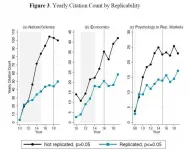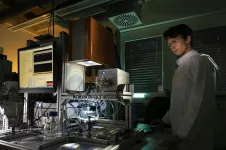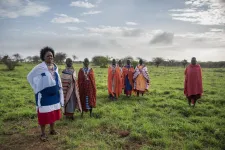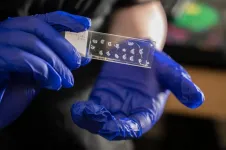New COVID-19 rapid test kit receives scientific seal of approval
2021-05-22
Simon Fraser University researchers have validated a faster, cheaper COVID-19 test that could kickstart the expansion of more widespread rapid testing. Study results have been published in The Journal of Molecular Diagnostics.
"This research offers a cheaper, faster alternative to the most reliable and sensitive test currently used worldwide, without sacrificing sensitivity and reproducibility," says molecular biology and biochemistry professor Peter Unrau, who led the team evaluating the COVID-19 test kit.
The researchers suggest the test could be deployed in remote locations, clinics and airports due to its ease of use and portability.
The microchip real-time PCR test can provide ...
Researchers create world's most power-efficient high-speed ADC microchip
2021-05-21
To meet soaring demand for lightning-quick mobile technology, each year tech giants create faster, more powerful devices with longer-lasting battery power than previous models.
A major reason companies like Apple and Samsung can miraculously pull this off year after year is because engineers and researchers around the world are designing increasingly power-efficient microchips that still deliver high speeds.
To that end, researchers led by a team at Brigham Young University have just built the world's most power-efficient high-speed analog-to-digital converter (ADC) microchip. An ADC is a tiny piece of technology present in almost every electronic piece of equipment that converts analog ...
Clues from soured milk reveal how gold veins form
2021-05-21
For decades scientists have been puzzled by the formation of rare hyper-enriched gold deposits in places like Ballarat in Australia, Serra Palada in Brazil, and Red Lake in Ontario. While such deposits typically form over tens to hundreds of thousands of years, these "ultrahigh-grade" deposits can form in years, month, or even days. So how do they form so quickly?
Studying examples of these deposits from the Brucejack Mine in northwestern British Columbia, McGill Professor Anthony Williams-Jones of the Department of Earth and Planetary Sciences and PhD student Duncan McLeish have discovered that these gold deposits form much like soured milk. When milk goes sour, the butterfat particles clump together to form a jelly.
Q&A with Anthony Williams-Jones and Duncan McLeish
What did you ...
Study shows which North American mammals live most successfully alongside people
2021-05-21
A team of researchers led by scientists at UC Santa Cruz analyzed data from 3,212 camera traps to show how human disturbance could be shifting the makeup of mammal communities across North America.
The new study, published in the journal Global Change Biology, builds upon the team's prior work observing how wildlife in the Santa Cruz Mountains respond to human disturbance. Local observations, for example, have shown that species like pumas and bobcats are less likely to be active in areas where humans are present, while deer and wood rats become bolder and more active. But it's difficult to generalize findings like these across larger geographic areas because human-wildlife interactions are often regionally unique.
So, to get a continent-wide ...
Providing medications for free leads to greater adherence and cost-savings, study shows
2021-05-21
Free access to essential medicines increases patient adherence to taking medication by 35 per cent and reduces total health spending by an average of over $1,000 per patient per year, according to a two-year study that tested the effects of providing patients with free and convenient access to a carefully selected set of medications.
The findings, published May 21 in PLOS Medicine, come as advocates urge Canada to carve a path toward single-payer, public pharmacare. Canada is the only country with universal healthcare that does not have a universal pharmacare program.
A group of researchers led by St. Michael's Hospital of Unity Health ...
A new replication crisis: Research that is less likely to be true is cited more
2021-05-21
Papers in leading psychology, economic and science journals that fail to replicate and therefore are less likely to be true are often the most cited papers in academic research, according to a new study by the University of California San Diego's Rady School of Management.
Published in Science Advances, the paper explores the ongoing "replication crisis" in which researchers have discovered that many findings in the fields of social sciences and medicine don't hold up when other researchers try to repeat the experiments.
The paper reveals that findings from studies that ...
Superficial relationship: Enzymes protect the skin by ignoring microbes and viruses
2021-05-21
The human body is constantly exposed to various environmental actors, from viruses to bacteria to fungi, but most of these microbial organisms provoke little or no response from our skin, which is charged with monitoring and protecting from external dangers.
Until now, researchers weren't quite sure how that happened -- and why our skin wasn't constantly alarmed and inflamed.
In a study published May 21, 2021 in Science Immunology, scientists at University of California San Diego School of Medicine identify and describe two enzymes responsible for protecting our skin and body's overall health from countless potential microbial intruders. These enzymes, called histone deacetylases (HDACs), inhibit the body's inflammatory response in the skin.
"We have figured ...
Controllability of ionization energy of atoms promises advancements in chemical synthesis
2021-05-21
Ionization energy is one of the most important physicochemical parameters. It is defined in terms of the amount of energy required to rip an electron from an atom. The dependence of the ionization energy on the atomic number determines the periodic law of chemical elements, which is assumed to be fundamentally constant. Based on the previously predicted effect of changing the electron mass, the research team showed that the ionization energy of atoms placed in photonic crystals with an ultrahigh refractive index can be significantly changed.
Photonic crystals ...
New research examines why some firms prepare for natural disasters and others don't
2021-05-21
Despite the increasing frequency and severity of floods, storms, wildfires and other natural hazards, some firms in disaster-prone areas prepare while others do not.
That issue was examined in a new study by Jennifer Oetzel, professor, American University and Chang Hoon Oh, William & Judy Docking Professor of Strategy, University of Kansas published in the Strategic Management Journal (SMJ).
"Due to the increased frequency and severity of floods, storms, epidemics, wildfires and other natural hazards anticipated over the coming decades (according to the National Oceanic and Atmospheric Administration), there is growing pressure on managers and their ...
How human cells and pathogenic shigella engage in battle
2021-05-21
DALLAS - May 21, 2021 - One member of a large protein family that is known to stop the spread of bacterial infections by prompting infected human cells to self-destruct appears to kill the infectious bacteria instead, a new study led by UT Southwestern scientists shows. However, some bacteria have their own mechanism to thwart this attack, nullifying the deadly protein by tagging it for destruction.
The findings, published online today in Cell, could lead to new antibiotics to fight bacterial infections. And insight into this cellular conflict could shed light on a number of other conditions in which this protein is involved, including asthma, Type 1 diabetes, primary biliary cirrhosis, and Crohn's disease.
"This ...
OU researcher identifies new mode of transmission for bacteria
2021-05-21
OKLAHOMA CITY AND DENMARK - Campylobacter infection, one of the most common foodborne illnesses in the Western world, can also be spread through sexual contact, according to a new research discovery by an OU Hudson College of Public Health faculty member, working in conjunction with colleagues in Denmark.
The team's research has been published in Emerging Infectious Diseases, a journal published by the Centers for Disease Control and Prevention (CDC), and is the first known study to prove this mode of transmission for Campylobacter. During a time when COVID-19 has dominated news about infectious diseases, the research is a reminder that many other pathogens affect lives around the world every day. The study was led by infectious disease epidemiologist Katrin ...
Sand's urban role demands key part on sustainability stage
2021-05-21
Over 20 Indonesian islands mysteriously disappear. One of the world's deadliest criminal syndicates rises to power. Eight cities the size of New York will be built every year for the next three decades. What connects them is sand, embedded in the concrete of nearly all of the world's buildings, roads, and cities, the glass in the windows, laptops and phone screens, and COVID-19 vaccine vials.
The unexamined true costs of sand - broadly, construction aggregates production -- has spurred a group of scientists to call for a stronger focus on understanding the physical dimension of sand use and extraction. They also suggest new ways to achieve economic and environmental justice.
Four years ago, an international group of scientists, including two from Michigan State University (MSU), called ...
Medication use in hospitalized patients with COVID-19
2021-05-21
What The Study Did: Medication use among hospitalized patients for COVID-19-related treatment in a large university health care system was examined in this study.
Authors: Jonathan H. Watanabe, Pharm.D., Ph.D., of the University of California, Irvine, School of Pharmacy & Pharmaceutical Sciences, is the corresponding author.
To access the embargoed study: Visit our For The Media website at this link https://media.jamanetwork.com/
(doi:10.1001/jamanetworkopen.2021.10775)
Editor's Note: Please see the article for additional information, including other authors, author contributions and affiliations, conflict of interest and financial disclosures, and funding and support.
INFORMATION:
Media advisory: ...
Women's access to abortion care under Oregon's reproductive health equity act
2021-05-21
What The Study Did: Oregon's Reproductive Health Equity Act ensured coverage for family planning (abortion and contraception) using state funds for all low-income state residents regardless of citizenship status. Researchers in this study describe the first two years of abortion services covered and the distances traveled by women to receive care.
Authors: Maria I. Rodriguez, M.D., M.P.H., of Oregon Health & Science University in Portland, is the corresponding author.
To access the embargoed study: Visit our For The Media website at this link https://media.jamanetwork.com/
(doi:10.1001/jamahealthforum.2021.0402)
Editor's ...
Examining variation in SARS-CoV-2 infection risk, socioeconomic disadvantage in Mayan-Latinx population
2021-05-21
What The Study Did: Variation in SARS-CoV-2 infection risk and socioeconomic disadvantage among a Mayan-Latinx population in Fruitvale, California, was examined in this study.
Authors: Paul Wesson, Ph.D., of the University of California, San Francisco, is the corresponding author.
To access the embargoed study: Visit our For The Media website at this link https://media.jamanetwork.com/
(doi:10.1001/jamanetworkopen.2021.10789)
Editor's Note: The article includes conflict of interest and funding/support disclosures. Please see the article for additional information, including other authors, author contributions and affiliations, ...
Long-term gluten intake, cognitive function among women
2021-05-21
What The Study Did: This observational study found no association between long-term dietary intake of gluten and cognitive function among a large group of middle-age women without celiac disease.
Authors: Andrew T. Chan, M.D., M.P.H., of Massachusetts General Hospital and Harvard Medical School in Boston, is the corresponding author.
To access the embargoed study: Visit our For The Media website at this link https://media.jamanetwork.com/
(doi:10.1001/jamanetworkopen.2021.13020)
Editor's Note: The article includes conflict of interest and funding/support disclosures. Please see the article for additional information, including other authors, author contributions and affiliations, conflict of interest and financial disclosures, and funding and support.
# ...
Brain's memory center stays active during 'infantile amnesia'
2021-05-21
One trait shared by all humans is that they don't remember specific life episodes that occurred before the age of 3 or 4. Many scientists have attributed this so-called "infantile amnesia" to a lack of development in the hippocampus, an area of the brain located in the temporal lobe that is crucial to encoding memory.
However, a new brain imaging study by Yale scientists shows that infants as young as three months are already enlisting the hippocampus to recognize and learn patterns. The findings were published May 21 in the journal Current Biology.
"A fundamental mystery ...
Efforts to treat COVID-19 patients chronicled in UC Health medications data
2021-05-21
Irvine, Calif. - A record of medicine utilization patterns assembled by an interdisciplinary team of researchers at the University of California, Irvine and the UC San Diego School of Medicine reveals the thought, care and scientific rigor clinicians at UC Health medical centers applied in their treatment of patients with COVID-19 in 2020.
For a study published today in Journal of the American Medical Association Network Open, the investigators examined data on the usage rates of 10 different medicines and medicine categories to map how drugs were used on people hospitalized with the viral infection.
The authors got their data ...
Water treatment: Removing hormones with sunlight
2021-05-21
Micropollutants such as steroid hormones contaminate drinking water worldwide and pose a significant threat to human health and the environment even in smallest quantities. Until now, easily scalable water treatment technologies that remove them efficiently and sustainably have been lacking. Scientists at the Karlsruhe Institute of Technology (KIT) developed a new chemical process for removing hormones. It takes advantage of the mechanisms of photocatalysis and transforms the pollutants into potentially safe oxidation products. The team reports on this in the scientific ...
Pivotal results from Trinity clinical trial for the chronic condition atopic dermatitis
2021-05-21
The findings of a clinical trial by Trinity College Dublin researchers of treatment for atopic dermatitis have been published today in The Lancet journal (Friday, 21st May, 2021). Results of the clinical trial at the School of Medicine, Trinity College and St James's Hospital, Dublin have shown the drug upadacitinib to be the most effective treatment to date for this chronic, relapsing inflammatory condition. The research is vital as there is an unmet need which exists for therapies that provide remission of symptoms in moderate-to-severe atopic dermatitis.
The publication reports efficacy and safety results of upadacitinib compared with placebo for the treatment of moderate-to-severe atopic dermatitis in adults and adolescents. This pivotal Global Phase ...
Indigenous peoples and local communities, key to achieving biodiversity goals
2021-05-21
An international study led by the ICTA-UAB states that recognizing indigenous peoples' and local communities' rights and agency is critical to addressing the current biodiversity crisis
Policies established by the post-2020 Global Biodiversity Framework of the Convention on Biological Diversity (CBD) could be ineffective if the rights and agency of indigenous peoples and local communities are not recognized and fully incorporated into biodiversity management. This is supported by an international study led by the Institute of Environmental Science and Technology of the Universitat Autònoma de Barcelona (ICTA-UAB) and recently published in the journal Ambio.
The ...
Scientists created building materials effectively protecting from radiation
2021-05-21
Scientists at the Ural Federal University (UrFU, Russia) have created clay bricks that are able to attenuate ionizing radiation to a level that is safe for the human body. To the composition of bricks scientists add waste from the industry, which protects against radiation. The article describing the technology was published in the journal Applied Radiation and Isotopes.
"Bricks are a relatively cheap and convenient material with which we can quickly erect protective rooms, structures, walls around objects with radiation," says scientific head of the project, associate professor of the Department of Nuclear Power Plants and Renewable Energy Sources at UrFU Oleg Tashlykov. "The bricks ...
Itch insight: Skin itch mechanisms differ on hairless versus hairy skin
2021-05-21
Chronic skin itching drives more people to the dermatologist than any other condition. In fact, the latest science literature finds that 7% of U.S. adults, and between 10 and 20% of people in developed countries, suffer from dermatitis, a common skin inflammatory condition that causes itching.
"Itch is a significant clinical problem, often caused by underlying medical conditions in the skin, liver, or kidney. Due to our limited understanding of itch mechanisms, we don't have effective treatment for the majority of patients," said Liang Han, an assistant professor in the Georgia Institute of Technology's School of Biological Sciences who is also a researcher in the Parker H. Petit Institute for Bioengineering and Bioscience.
Until ...
Darwin foreshadowed modern scientific theories
2021-05-21
When Charles Darwin published Descent of Man 150 years ago, he launched scientific investigations on human origins and evolution. This week, three leading scientists in different, but related disciplines published "Modern theories of human evolution foreshadowed by Darwin's Descent of Man," in Science, in which they identify three insights from Darwin's opus on human evolution that modern science has reinforced.
"Working together was a challenge because of disciplinary boundaries and different perspectives, but we succeeded," said Sergey Gavrilets, lead author and professor in the Departments of Ecology and Evolutionary Biology and Mathematics at the University of Tennessee, Knoxville.
Their goal with this review summary was to apply the framework ...
SPRINT study confirms controlled blood pressure important in preventing heart disease and stroke
2021-05-21
CLEVELAND - Follow-up data from the landmark SPRINT study of the effect of high blood pressure on cardiovascular disease have confirmed that aggressive blood pressure management -- lowering systolic blood pressure to less than 120 mm Hg -- dramatically reduces the risk of heart disease, stroke, and death from these diseases, as well as death from all causes, compared to lowering systolic blood pressure to less than 140 mm Hg. Systolic blood pressure (SBP) is the upper number in the blood pressure measurement, 140/90, for example.
In findings published in the May 20, 2021 issue of the New England Journal of Medicine, investigators presented new evidence of the effectiveness of reducing SBP to a target range of less than 120 ...
[1] ... [2172]
[2173]
[2174]
[2175]
[2176]
[2177]
[2178]
[2179]
2180
[2181]
[2182]
[2183]
[2184]
[2185]
[2186]
[2187]
[2188]
... [8700]
Press-News.org - Free Press Release Distribution service.












